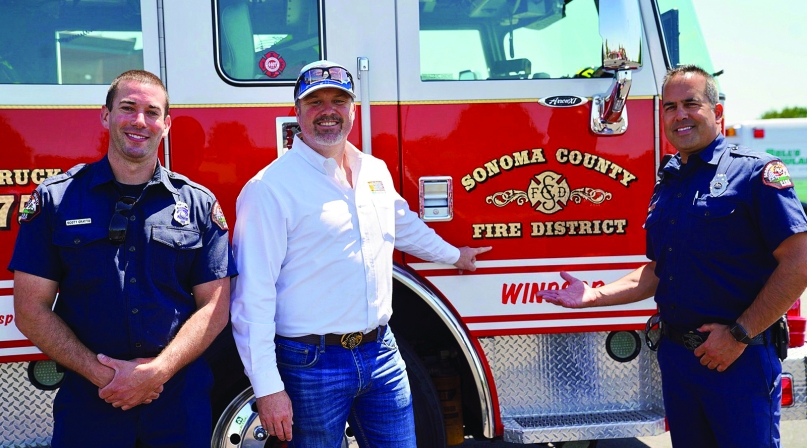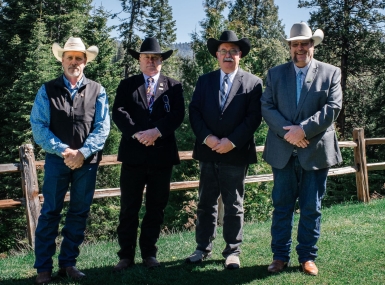Fire season: are we ready?
Author

Hon. James Gore
Upcoming Events
Related News

The words fire, drought and flood are now linked with everyday life in California. And while we responded well to the floods this winter, almost everyone in our community has their gaze set on fire season.
Everywhere I go around Sonoma County people ask me, “Are we ready?”
When I talk to our fire survivors and block captains, they challenge me, “Are we ready?”
When I talk with the communities I represent in the wildland-urban-interface, I’m asked, “Are we ready?”When I drop my kids off at school I think, “Are we ready?”
The true answer is that ready is a verb, not a noun.
As I’ve learned since the 2017 fire siege, ready is about imperfect, relentless progress. Ready is not a state to achieve, but rather a culture to embrace.
While some assume that ready is about perfect, the reality is that ready is about the constant pursuit of better. At a town hall recently, a good friend and fire chief plainly told the audience, “When you need me the most, I probably won’t be there. There are not enough professionals to cover everyone, so I need you all to work with me to prepare yourselves.”
This brutal honesty is necessary in our current day and age. There is no system that will save us. Not government, not first responders, not businesses, not nonprofits. Ready is about all of these institutions together, and more so, it’s about you and me.
As a community, we have been awoken by experience. Before our fire siege, I never imagined I would be giving speeches on disaster recovery and resilience but there I was, a local county supervisor, testifying before Congress on FEMA policies. There I was keynoting the Governor’s first emergency management summit. And the biggest thing I can tell people is what I demand of myself and my staff every day: “Wake up. Wake up others. And stay woke.”
From a county government perspective, when I look at how we’re more ready than ever, I first look to the institutional changes we’ve made in how the county does business. That’s a $500,000 investment in fire cameras, $1.2 million investment into up-staffing the Department of Emergency Management, $46 million in grants to FEMA on the table with 25 percent coming from us to take rapid action and $1 million in up-staffing for emergency services during red flag events.
Next, I look at the absolute need to share progress with the community in real time. Last September, we tested our Wireless Emergency Alert system, our electronic broadcast system and our reverse 9-1-1. This allowed us to finally move forward on the necessary, difficult task of managing technology and communications before, during and after tragedy strikes. We reached an agreement with all of our alerting agencies on common verbiage, we have a Memorandum of Understanding on Nixle accounts, a one-stop-shop for critical information at socoemergency.org and all of that has come from the difficult lessons we learned during our catastrophic wildfires.
Ready does not just mean standing on high alert all the time, it means institutionalizing emergency preparedness. To that end we created a Recovery and Resiliency Framework that guides our strategic, measurable actions to prepare our community for any and all hazards, may those be natural or man-made. The framework includes 215 actions, a top 10 list which includes alert and warning and evacuation routes, “home hardening” and a robust 2-1-1 system.
With so many efforts ongoing, some initiatives have already shown success, but there is so much left to do. To truly be ready, community preparedness needs to live in the community itself; we have to expect that during the next earthquake or fire or flood, we will be on our own for 72 hours. State Mutual Aid is a powerful network, but true resilience must come from local and regional self-reliance. To that end, we’re partnering with our brothers and sisters in the entire North Bay and North Coast in vegetation management, fuels reduction, and advanced planning for evacuation, sheltering and similar resilience initiatives.
Every time I have an opportunity to talk to one of my peers from another county, I grab them by the shoulders and I shout, “Wake up! Don’t wait to get smacked in the face to learn your lesson.”
I write this message with the same intention: To shake everyone, to grab each of you who reads it by the shoulders to wake up as well. Manage your land, prepare your family and spread the message that the new normal is here and we’re ready for it. Join me in the never-ending campaign for imperfect, relentless progress.
Attachments
Related News

Mariposa County finds third time’s a charm for WIR
The Western Interstate Region made up for lost time during its conference in Mariposa County, Calif., welcoming the state of Nebraska and addressing pressing issues for public lands counties.

County Countdown – May 7, 2024
Every other week, NACo’s County Countdown reviews top federal policy advocacy items with an eye towards counties and the intergovernmental partnership.

U.S. House passes suite of public lands legislation
The U.S. House considered a series of natural resource and public lands legislation addressing issues impacting public lands counties